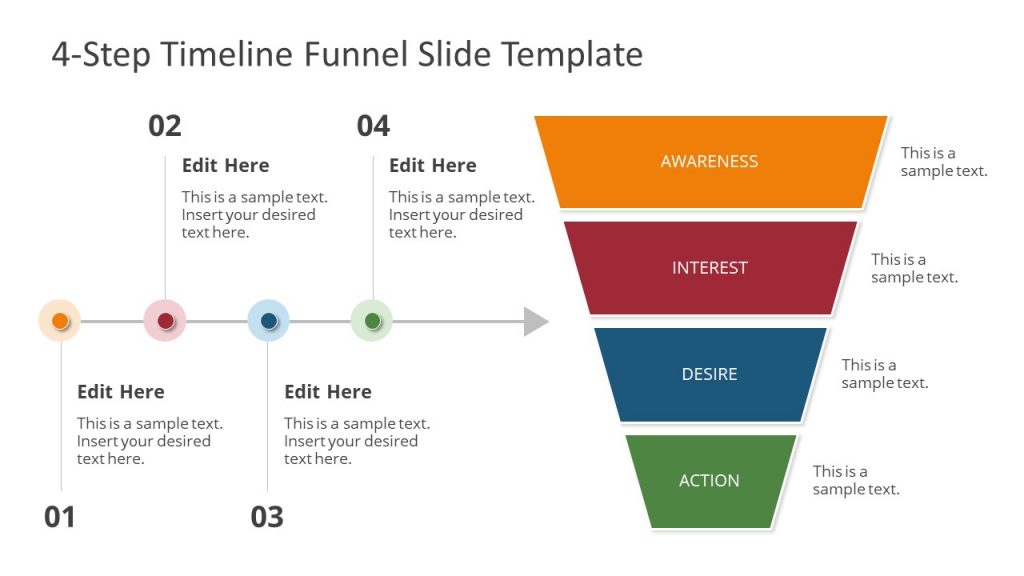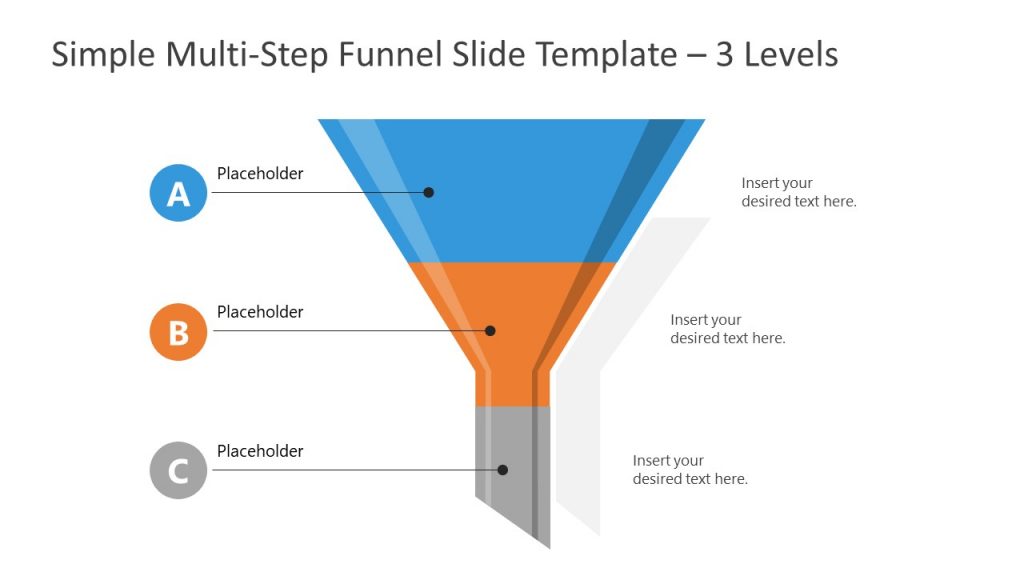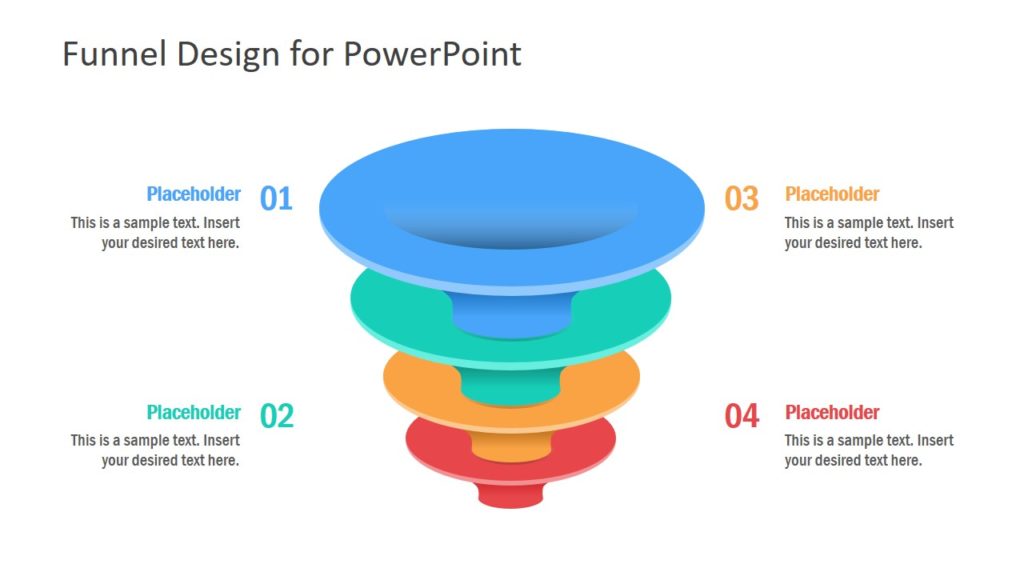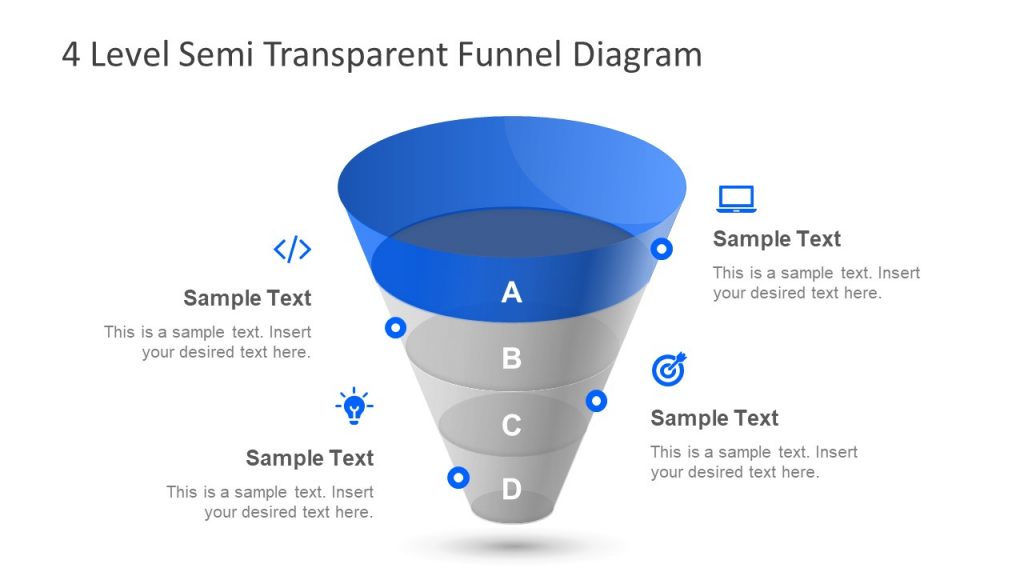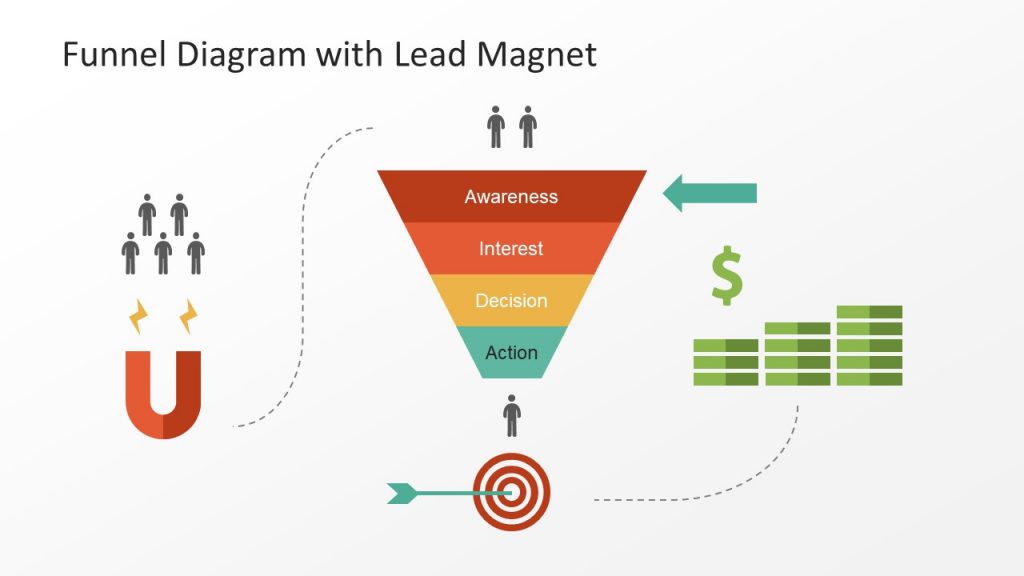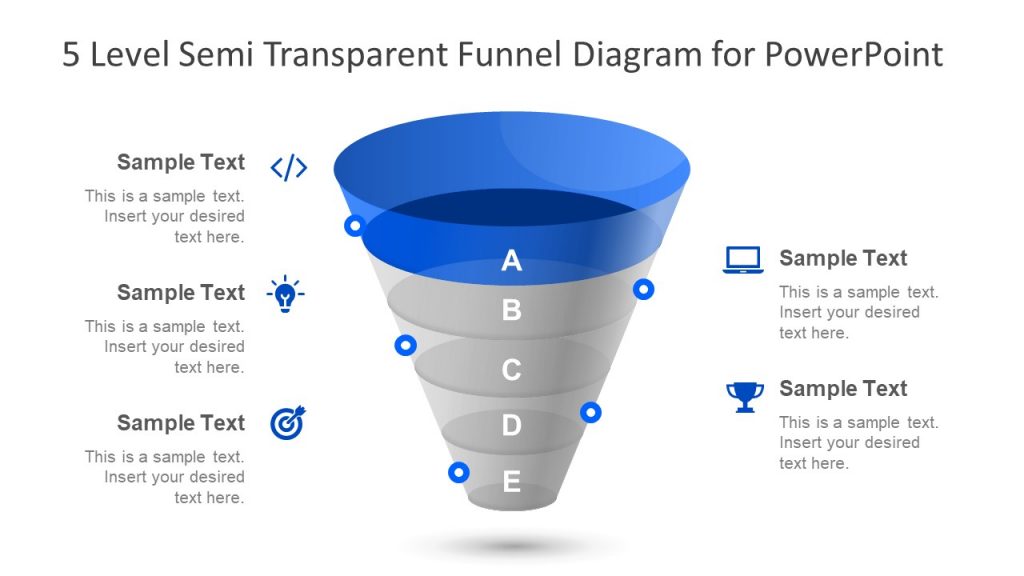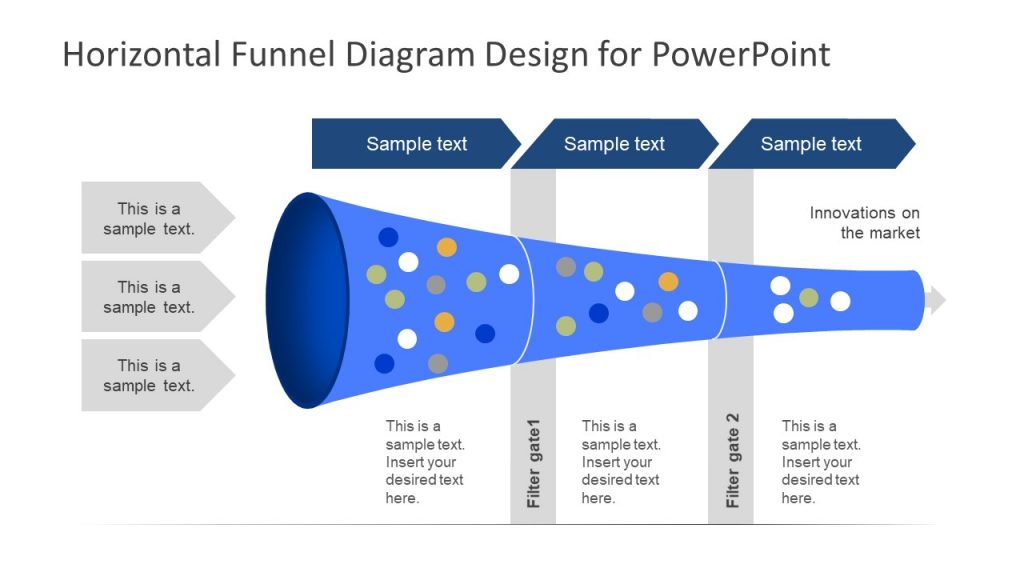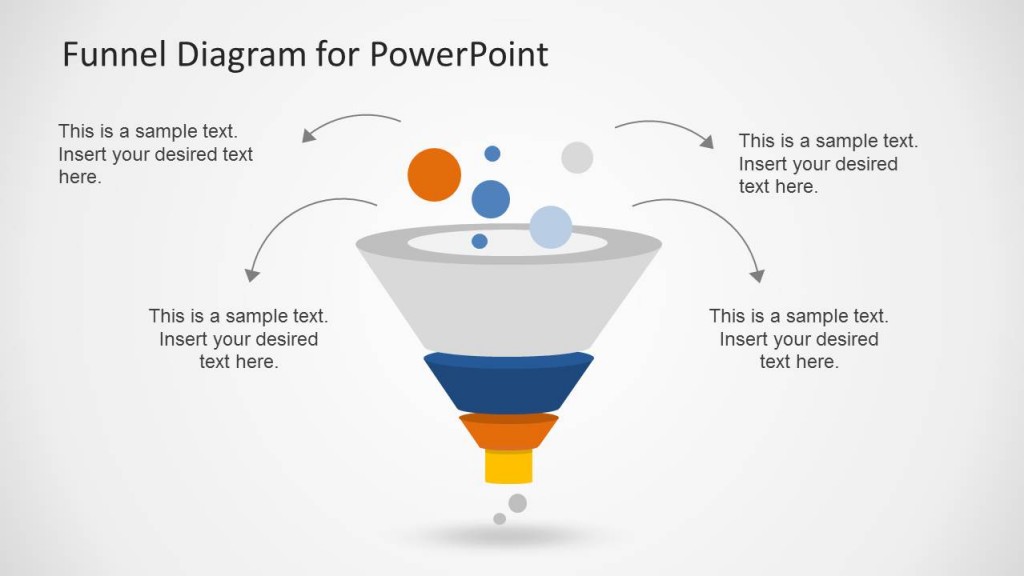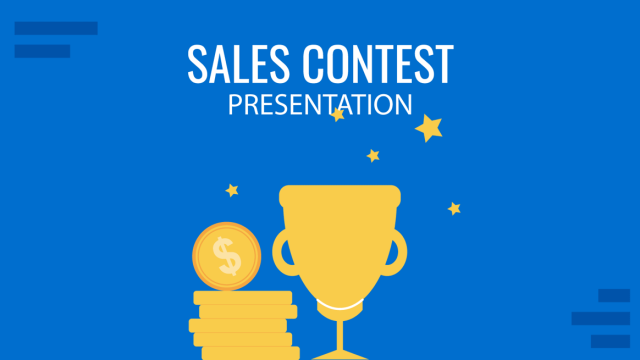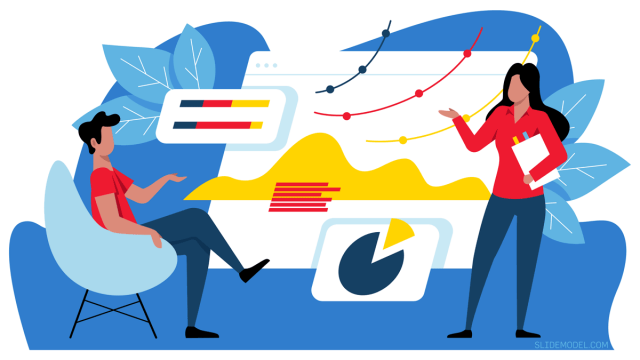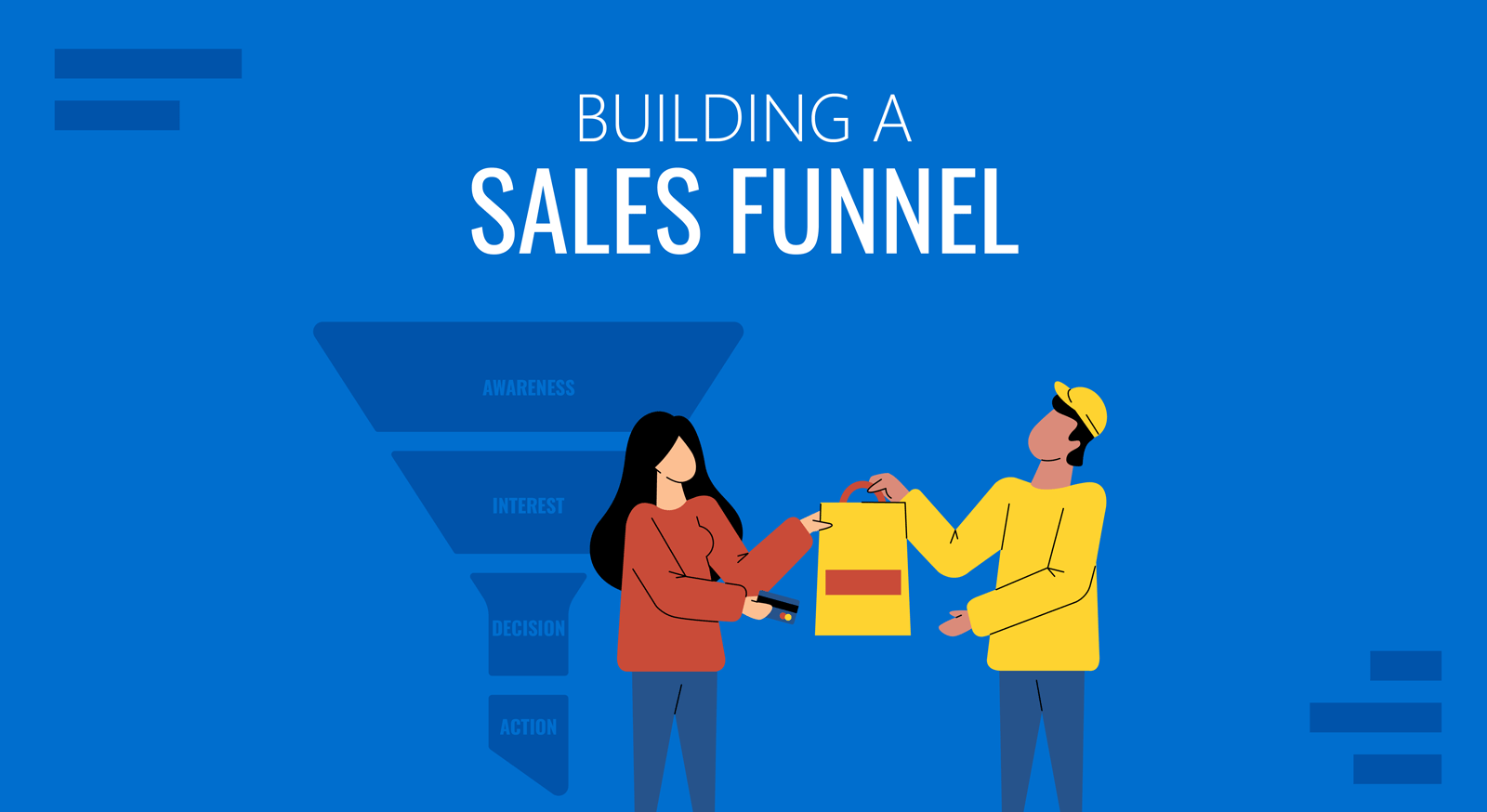
For any business, every prospect that ends up making a purchase goes through a process called the sales funnel. The process begins from the moment they learn about the business’s products and services and ends with them buying the said product or service.
A sales funnel has different stages every customer and prospect goes through, and to effectively convert leads into sales, it is essential for businesses to build a proper sales funnel, understand how to successfully manage it, and optimize it for minimizing potential loopholes that get in the way of customers making a purchase.
In this article, we explain what a sales funnel is and why it is a must-have for every business. Then we will dive into the stages of a sales funnel, and how to build a sales funnel for a streamlined sales process.
Lastly, we explain the sales funnel using an example, and as a bonus, we have included easy-to-use PowerPoint and Google Slides templates that can be used to create and present a sales funnel.
What is a Sales Funnel?
Simply put, a sales funnel is the process that each prospect goes through to become a customer of any business. It has different stages depending on the business model, and each stage of the sales funnel takes prospects one step closer to converting into a buyer, as they decide whether or not to make a purchase.
Every business can be modeled with a sales funnel, whether it is a brick-and-mortar store, an eCommerce website, or a services business. Sales funnels are also for both B2C and B2B businesses, where marketers aim to understand the journey of their customers and analyze how they can optimize it to build the demand for their products or services.
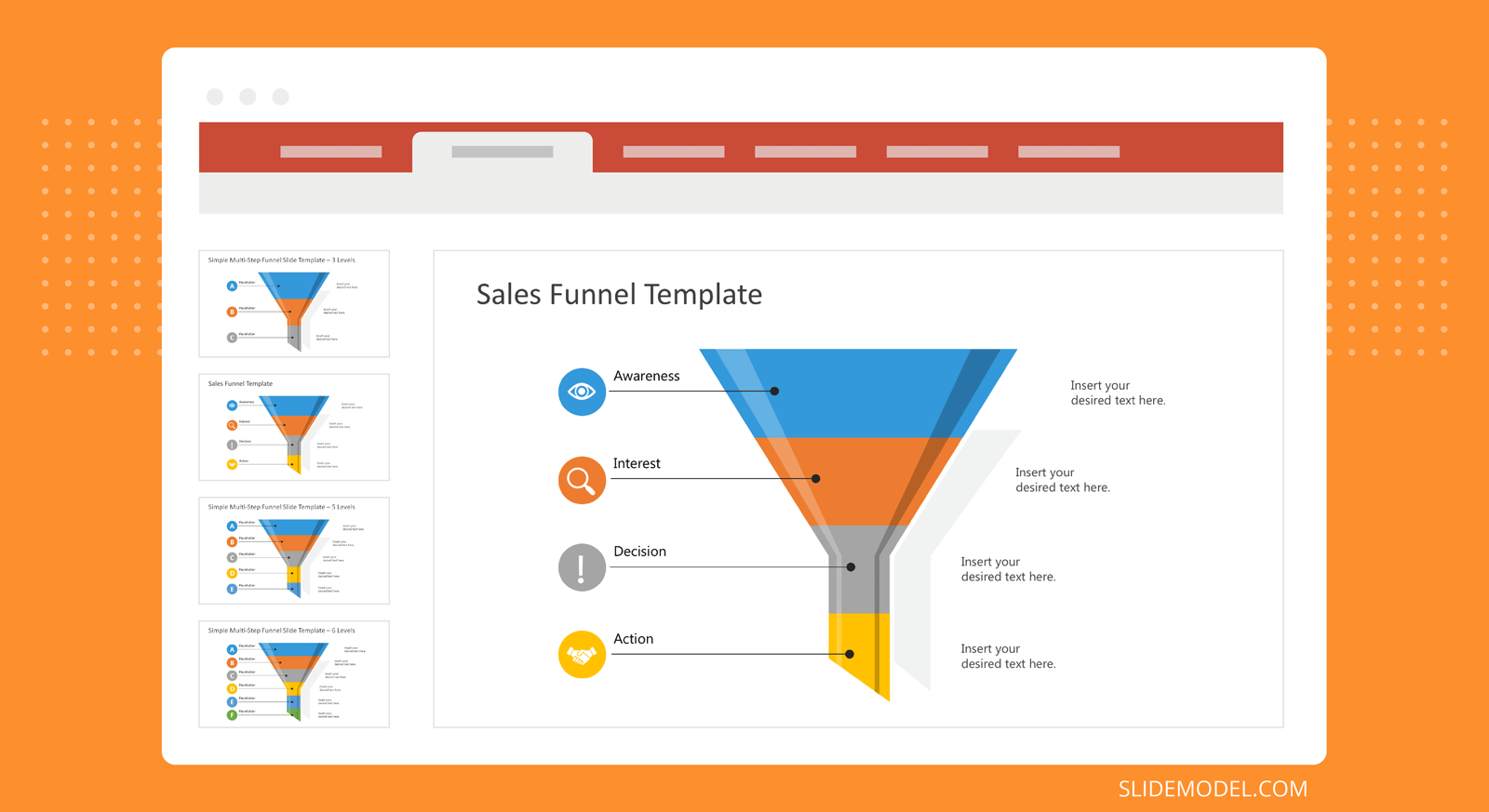
This multi-stage process is termed a sales funnel because it begins with attracting many prospective customers and then narrows down to a few that actually convert into buyers by going through the ToFu, MoFu, and BoFu stages.
What are the Different Types of Sales Funnels and Models?
Since a buyer’s journey for business is a distinct multi-stage process, there are different types of sales funnel models with added stages to the purchase process and provide the right type of engagement to customers.
The simplest and most popular sales model is the AIDA model, which stands for Attention, Interest, Decision, and Action.
It was revised by Arthur Frederick Sheldon where he added a 5th. step called “Satisfaction” for the purpose analyze the emotions of customers after buying the product or service.
While McKinsey’s Loyalty Loop added the Loyalty stage to the AIDA model to evaluate post-purchase experience by analyzing resales.

Other types of sales funnel models include the Forrester Model, the Heinz Marketing Bowtie, the Conversion funnel, JB Media Group’s sales funnel, and RAIN Group’s buying process which are mostly made for analyzing the B2B customer journey.
What is the Purpose of a Sales Funnel?
A sales funnel illustrates the journey a customer takes from start to finish. It helps marketers analyze why some prospects convert while some lose interest along the way, drop out, and don’t make a purchase.
Having a proper sales funnel in place helps to make a funnel analysis, and identify possible holes from where the prospects start losing interest, allowing marketers to optimize and increase conversion. A conversion funnel analysis can help digital marketers and professionals to understand which areas of the funnel can be optimized. By improving the non-converting areas through conversion funnel optimization, the conversion rate can be improved, and ultimately generating more revenue to the business.
Optimization of a sales funnel can sometimes be simple, like changing the ad copy, while at other times, marketers might need to do a complete overhaul of their sales strategy. Aligning the sales pitch and sales presentations with your target audience can also help toward optimizing the sales funnel. This is especially important in B2B selling.
Moreover, sales funnels are not static and need to be evolved over time to meet customer needs and deliver the right message at the right moment to turn more prospects into buyers and returning customers. For this purpose, marketers combines sales funnel analysis with other techniques, like cohort analysis. This way, marketers can map KPIs by sales funnel stages & different cohorts..
The AIDA Model — Stages of a Sales Funnel
Customers either make a purchase or don’t but they usually pass through the four main stages called AIDA, which stands for Attention, Interest, Decision, and Action.
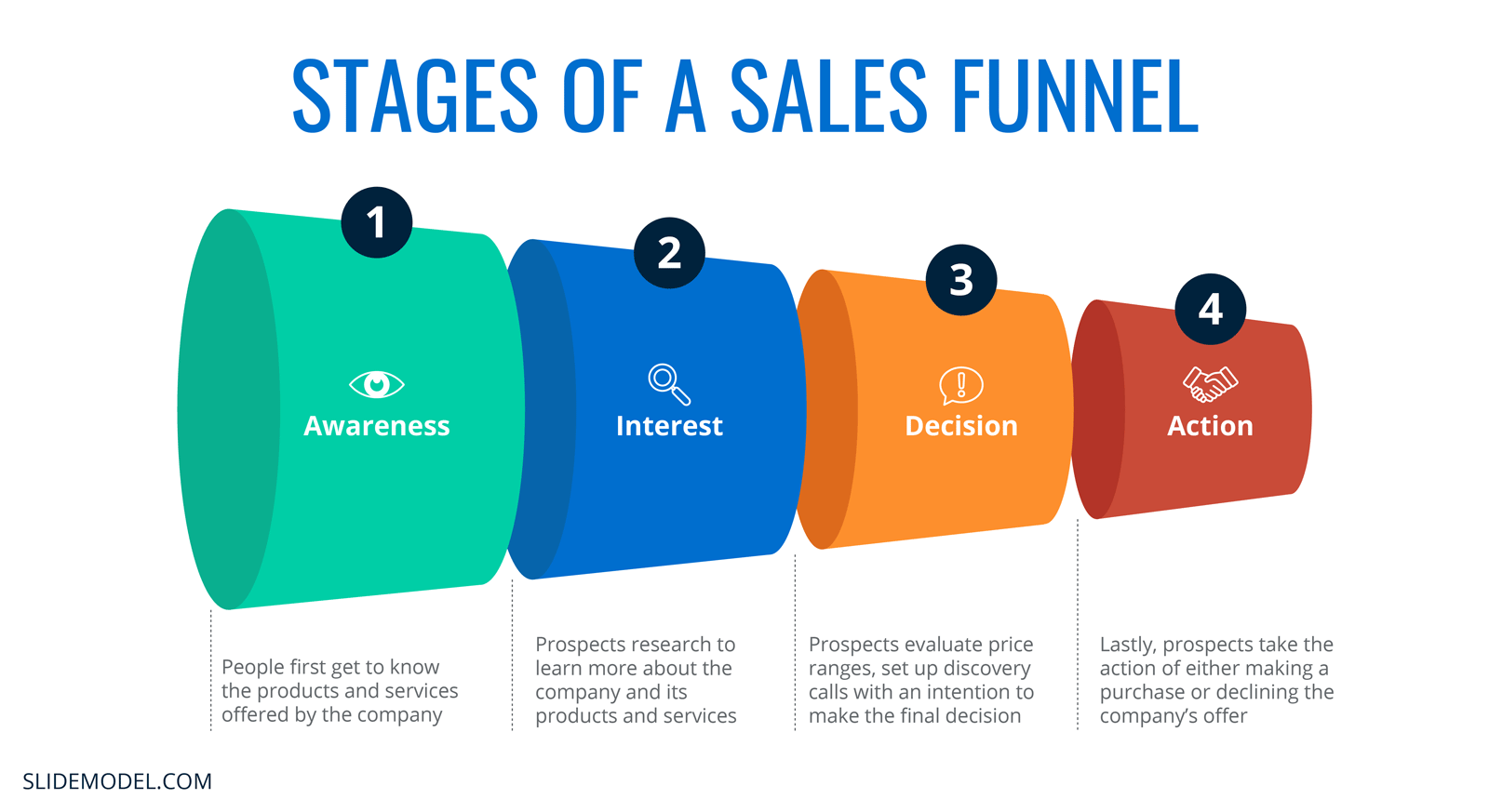
1. Awareness
When people first get to know the products and services offered by the company is the awareness stage. This is generally done by marketers through different advertising strategies, such as paid media, paid social campaigns, influencer marketing, referrals, or content marketing. Here, you try to capture a cold audience, and that’s why this is often identified as the cold stage of the sale funnel.
2. Interest
When a prospect starts taking an interest after getting to know the company’s products and services, they are at the interest stage of the sales funnel. At this stage, prospects usually research to learn more about the company and its products and services. They might even compare the products with competitors to determine which is best.
3. Decision
Next is the decision stage, where prospects start evaluating price ranges, get in touch with sales representatives, or even set up discovery calls with an intention to make the final decision.
4. Action
Lastly, after careful consideration, prospects take the action of either making a purchase or declining the company’s offer. This is often referred as the hot stage of the sales funnel, where a hot audience is captured.
How to Build a Sales Funnel?
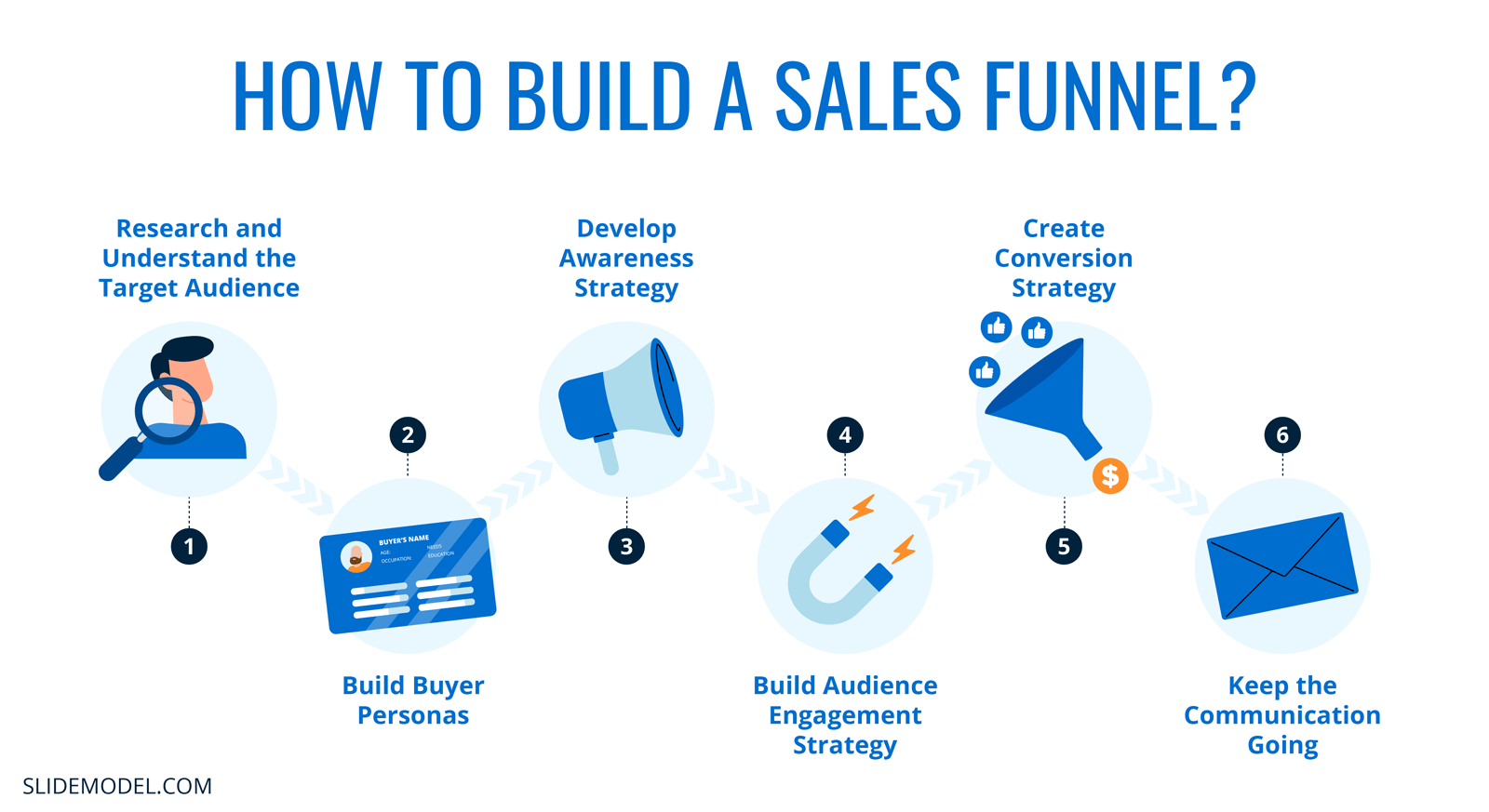
1. Research and Understand the Target Audience
The first and most important part of building a sales funnel is researching and understanding the target audience of the products or services the business offers.
Marketing is not done to everybody but rather to a specific group of people who are a good fit for what the business is offering. Answer questions about the target audience and know their pain points, fears, frustrations, goals, desires, aspirations, and know their behaviors to learn how to create awareness of the products and services effectively. Address how the offering can solve their problems and increase their satisfaction.
2. Build Buyer Personas
As the target audience becomes clear, it is necessary to build buyer personas from the data gathered. Analyze how they react to the businesses marketing media to refine buyer personas and effectively create strategies to persuade them to make a purchase.
Depending on the product or service category, the business might require multiple funnels since the target audience doesn’t generally fit into a single category. Buyer personas vary, and therefore, it is best to personalize the marketing materials for different personas to make the messages relevant and effective.
3. Develop Awareness Strategy
After building personas, an awareness strategy needs to be developed to let the target audience know what the business offers. A holistic traffic strategy is necessary; whether the business is a B2B or B2C, a brick-and-mortar store or an online store, people need to be lured into the top of the funnel so they can learn about the products and services.
For awareness, businesses can use rich media like infographics, videos, and advertisements so the target audience can know what you offer and develop an interest. It can also be achieved through word-of-mouth generated by existing customers who have had a delightful customer experience.
4. Build Audience Engagement Strategy
The next step is to create an audience engagement strategy. Here the focus is on generating leads, rather than capturing the sale. For a brick-and-mortar store, this could be a pleasant in-store experience, running experiential spaces, hosting events at the store and any other strategies that lets prospects learn more and interact with the brand.
Meanwhile, for an eCommerce business, visitors need to be directed to a landing with an offer they cannot miss. It should steer them toward the next step of becoming a buyer.
5. Create Conversion Strategy
Here the business needs to focus on getting the prospects to take action and convert into buyers. An incredible offer they cannot refuse will prompt them to hit the purchase button.
This can be done through sales calls, emails, and webinars, while for a brick-and-mortar store, a sales representative can make it easy for prospects to say yes. Pushing the benefits, diminishing their fears, and addressing the prospect’s question are the keys here to helping them make a decision.
Easy returns, a money-back guarantee, fast eCommerce fulfillment and delivery, a flexible payment plan, past client testimonials, and customer reviews can help in converting prospects into buyers. In addition to effective conversion strategies, leveraging platforms like LinkedIn can also serve as a potent source of lead generation.
6. Keep the Communication Going
Lastly, communication with the business’s current customers should be continued through different marketing approaches. Send customers additional coupon codes, ask them for a review of their purchase, involve them in your social media sphere, send them newsletters for new product launches, etc.
Maintaining relationships with existing customers is as important as creating new ones. It needs to be nurtured over time to gain more traction, generate good word-of-mouth and eventually obtain life-long customers through good customer engagement and satisfaction.
Sales Funnel Examples
Sales Funnel Example: Netflix
Netflix has built a highly efficient sales funnel that aligns with its position as a global leader in the streaming industry. By combining strategic marketing, personalized user engagement, and seamless user experience, Netflix attracts, retains, and converts millions of users worldwide. Let’s break down the Netflix sales funnel using the AIDA (Awareness, Interest, Desire, Action) model using one of the funnel templates provided by SlideModel.
Awareness:
Netflix creates awareness through widespread advertising campaigns, such as promotional trailers on platforms like YouTube, Facebook, and Instagram. The brand leverages its partnerships with content creators and actors, creating buzz around its exclusive Originals, like Stranger Things and The Crown. Word-of-mouth marketing and high SEO rankings for terms like “best shows to watch” and “Netflix Originals” attract organic traffic.
Interest:
Once potential customers learn about Netflix, the platform builds interest by showcasing its extensive library of high-quality content, including popular movies, TV shows, documentaries, and Originals. Netflix uses its free trial offer (in regions where available) or low-cost introductory plans to encourage users to experience its service risk-free. Personalized onboarding with AI-powered suggestions and previews tailored to a user’s taste keeps them engaged and exploring.
Desire:
Netflix strengthens desire by emphasizing its value proposition: unlimited streaming, ad-free content, and the ability to download and watch offline. Regionalized content, like local-language series and films, caters to diverse tastes and increases its appeal to specific markets. Netflix also uses social proof, such as user testimonials, awards, and critical acclaim for its Originals, to reinforce its quality and desirability.
Action:
Netflix ensures that the action step (sign-up) is frictionless. A simple, user-friendly sign-up process with multiple payment options ensures that potential customers can quickly convert into subscribers. Users can start watching immediately after signing up, with personalized recommendations and autoplay features creating an addictive experience from day one.
Sales Funnel Example: SlideModel
SlideModel.com’s sales funnel guides users from awareness to action by combining marketing strategies, engaging content, and a seamless user experience. The image below visualizes this funnel using the AIDA model.
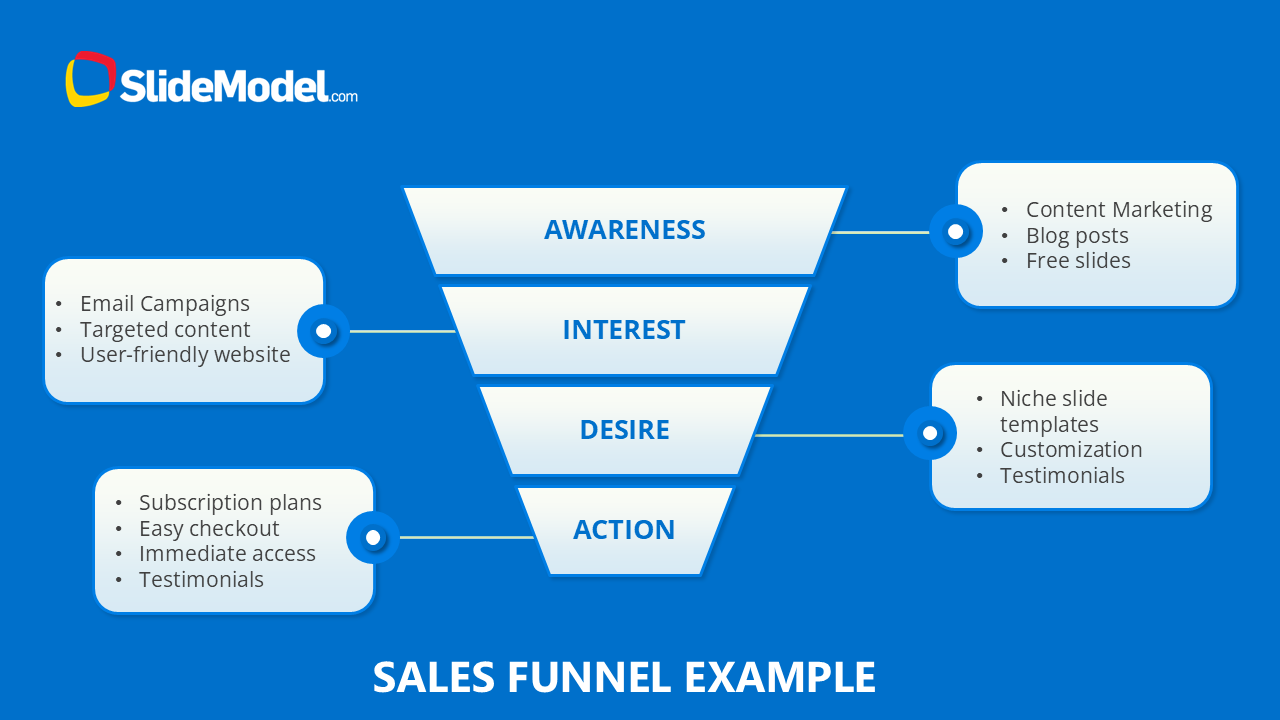
Awareness:
At the Awareness stage, SlideModel focuses on introducing the brand to a broad audience. This is achieved through content marketing efforts such as blog posts that provide value to presentation professionals and free slide offerings that allow users to experience SlideModel’s high-quality templates firsthand. These strategies create initial interest and establish SlideModel as a valuable resource.
Interest:
As potential customers move into the Interest stage, SlideModel employs engaging tactics to nurture their curiosity and keep them exploring. Email campaigns and targeted content through informational articles highlight the platform’s features, while a user-friendly website ensures visitors can easily navigate and explore the extensive library of presentation templates for PowerPoint & Google Slides. This stage is crucial for building a connection with users and encouraging them to delve deeper into what SlideModel offers.
Desire:
The Desire stage in the sales funnel focuses on showcasing the unique value SlideModel brings to its users. With niche slide templates tailored for various industries and purposes, customization features that allow full flexibility, and testimonials from satisfied customers, SlideModel builds trust and creates a strong desire among potential users. By emphasizing these benefits, SlideModel establishes itself as the go-to solution for presentation needs.
Action:
Finally, at the Action stage of the sales funnel, SlideModel makes it easy for users to subscribe and start using its slide templates. Flexible subscription plans cater to different customer needs, while an easy checkout process minimizes friction during the purchase journey. Immediate access to templates ensures users can start benefiting from their subscription right away. Testimonials & reviews from real customers further reassure users, providing the final push to complete their subscription.
The diagram above illustrates how SlideModel’s sales funnel effectively converts visitors into loyal customers. This structured approach ensures a seamless user journey, contributing to SlideModel’s growing customer base and reputation as a leader in presentation design resources.
Sales Funnel Example: AirBnb
Airbnb has revolutionized the travel industry with a well-crafted sales funnel that attracts travelers and hosts, engages them through personalized tools, and converts them into loyal users. Below is an explanation of how Airbnb’s sales funnel functions using the AIDA (Awareness, Interest, Desire, Action) model.
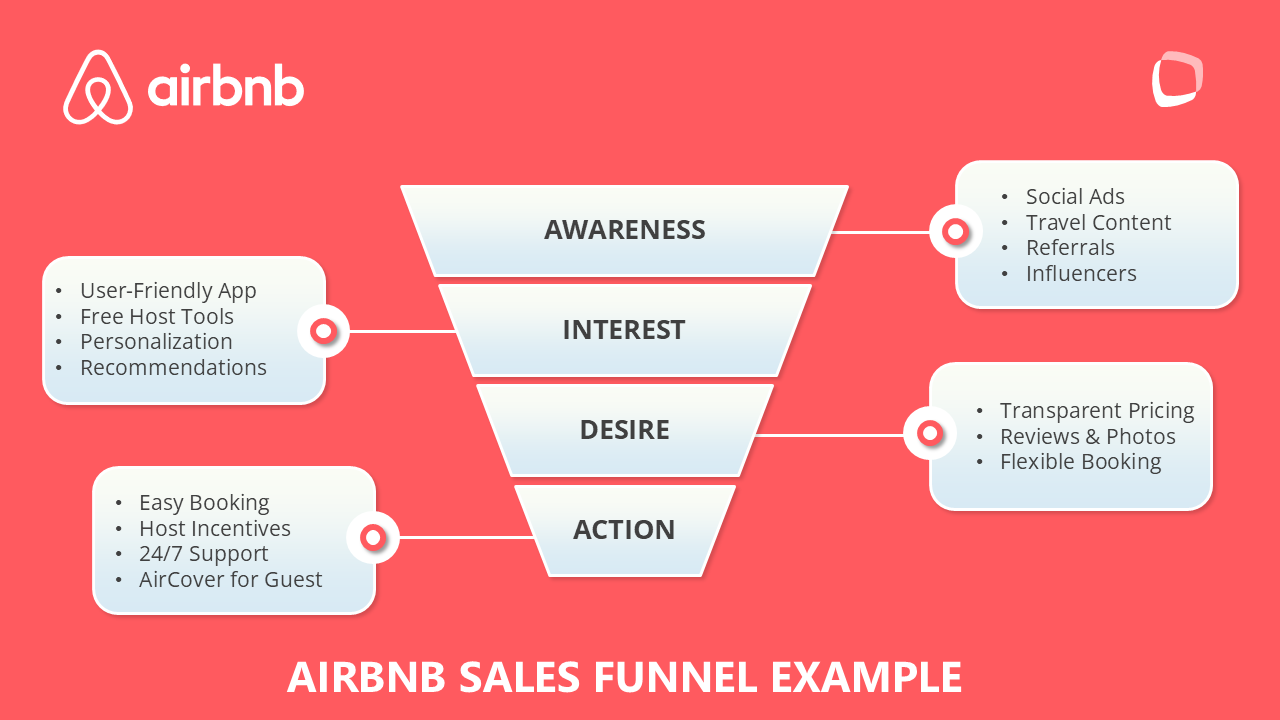
Awareness
The Awareness stage involves reaching a broad audience through social ads, travel-related content, and referrals. Airbnb leverages its global presence by using influencer marketing and partnerships with travel bloggers and creators to showcase its value. These efforts aim to capture attention and establish Airbnb as a household name in the travel accommodation industry.
Interest
At the Interest stage, Airbnb engages users by providing a user-friendly app and free hosting tools, making it simple for travelers and hosts to explore the platform. Personalization and recommendations are key, as Airbnb tailors its offerings based on user preferences and past searches, keeping potential customers intrigued and engaged.
Desire
In the Desire stage, Airbnb builds trust and strengthens user commitment by highlighting transparent pricing, customer reviews, and high-quality photos of properties. Flexible booking options further cater to travelers’ needs, making the platform appealing and encouraging users to move closer to booking.
Action
Finally, the Action stage ensures that the booking process is seamless. Airbnb simplifies the path to conversion with features like easy booking, host incentives, and round-the-clock support. The addition of “AirCover for Guests” reassures users about their booking decisions, providing peace of mind and driving conversions.
Airbnb’s approach goes beyond the AIDA model, focusing on retention and advocacy. Satisfied customers and hosts often recommend the platform to others, creating a cycle of organic growth. Airbnb’s ability to combine technology, personalization, and trust-building has made it a leader in the travel and hospitality industry.
Sales Funnel Example: SlideModel
Uber’s Sales Funnel: Seamlessly Connecting Riders and Drivers
Uber has established a highly efficient sales funnel that engages both riders and drivers, leveraging technology, marketing, and user-centric design to deliver a seamless experience. Here’s a detailed breakdown of Uber’s sales funnel example, describing its stages in the funnel.
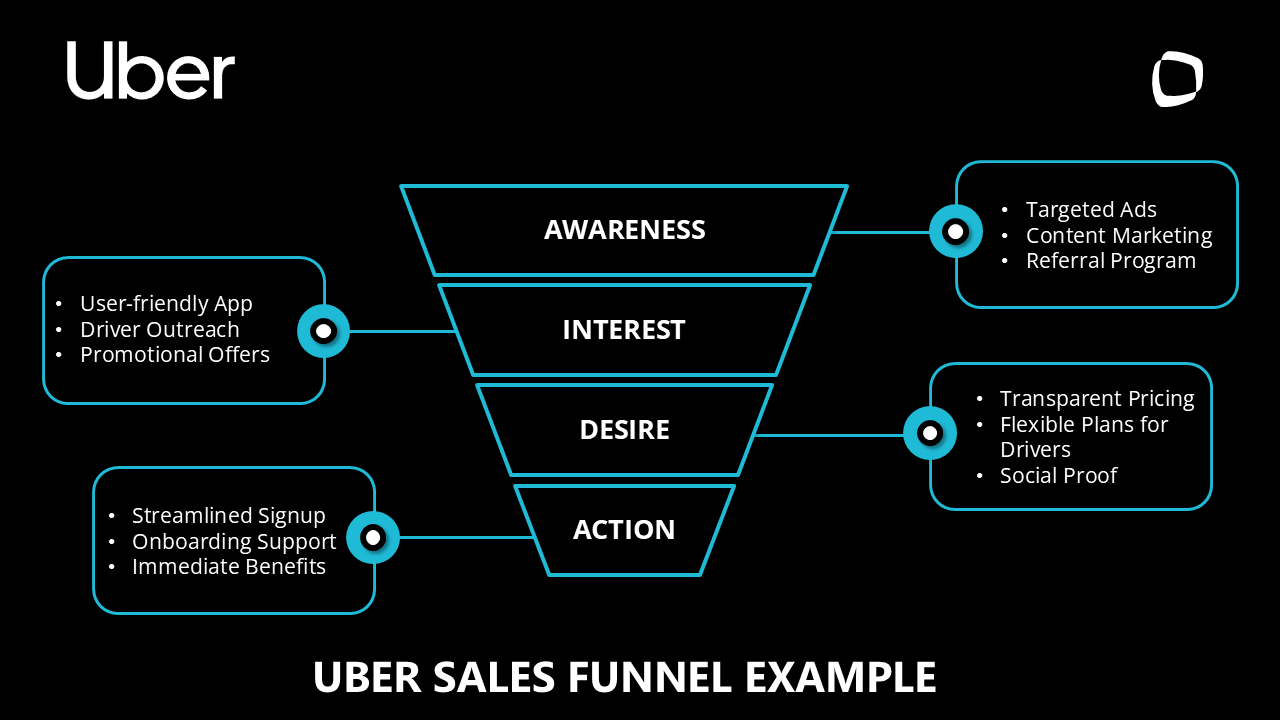
Awareness
The goal in the awareness stage of Uber’s sales funnel is to introduce potential riders and drivers to Uber’s platform. This is achieved through the following strategies:
Targeted Advertising: Uber invests heavily in digital ads on Google, Facebook, Instagram, and YouTube, emphasizing convenience, affordability, and income opportunities for drivers.
Content Marketing: Blogs, videos, and social media posts highlight Uber’s benefits, including flexible earnings for drivers and quick rides for passengers.
Referral Programs: Riders and drivers are incentivized to refer friends with discounts or bonuses.
Event Sponsorships: Uber sponsors major events, ensuring visibility in high-traffic areas and during peak travel times.
Example: A commuter sees a Facebook ad promoting Uber as an affordable and convenient way to travel and downloads the app.
Interest
The goal in this Interest stage of the sales funnel is to engage potential riders and drivers by showcasing Uber’s value. For this purpose, the following strategies are executed.
User-Friendly App: Uber’s intuitive interface allows users to easily explore ride options or sign up to drive.
Driver Outreach: Dedicated landing pages explain how drivers can earn, highlighting flexibility and weekly payouts.
Promotional Offers: New riders receive discounts on their first ride, while drivers are offered sign-up bonuses for completing a set number of trips.
Example: A student downloads the app after seeing a promotion for 50% off their first three rides.
Decision
In the Decision stage, the goal is to convert interested riders into users and potential drivers into partners. For this purpose, the following strategies are considered.
Transparent Pricing: Riders see upfront pricing before booking a trip, building trust and eliminating surprises. Even if it is implementing the dynamic pricing, the user knows the estimated total cost in advance.
Flexible Plans for Drivers: Uber offers drivers the flexibility to choose their hours, appealing to gig workers and those seeking supplemental income.
Social Proof: Ratings and reviews from riders and drivers highlight the reliability of Uber’s service.
Example: A new driver signs up after reading testimonials from other drivers about how they earn extra income.
Action
The goal in the Action stage of this sales funnel example is to convert riders into paying customers and drivers into active earners. Let’s see what strategies are considered in this action stage:
Streamlined Signup: Riders can book their first ride within minutes of downloading the app, and drivers can onboard with minimal paperwork.
Onboarding Support: Drivers receive step-by-step guidance, including video tutorials and local support centers, to get started.
Immediate Benefits: Riders enjoy quick pickups, while drivers can start earning right after onboarding.
Example: A busy professional books their first ride to the airport in San Francisco and is impressed by the prompt pickup and smooth trip.
Example of a Brick-and-Mortar Sales Funnel
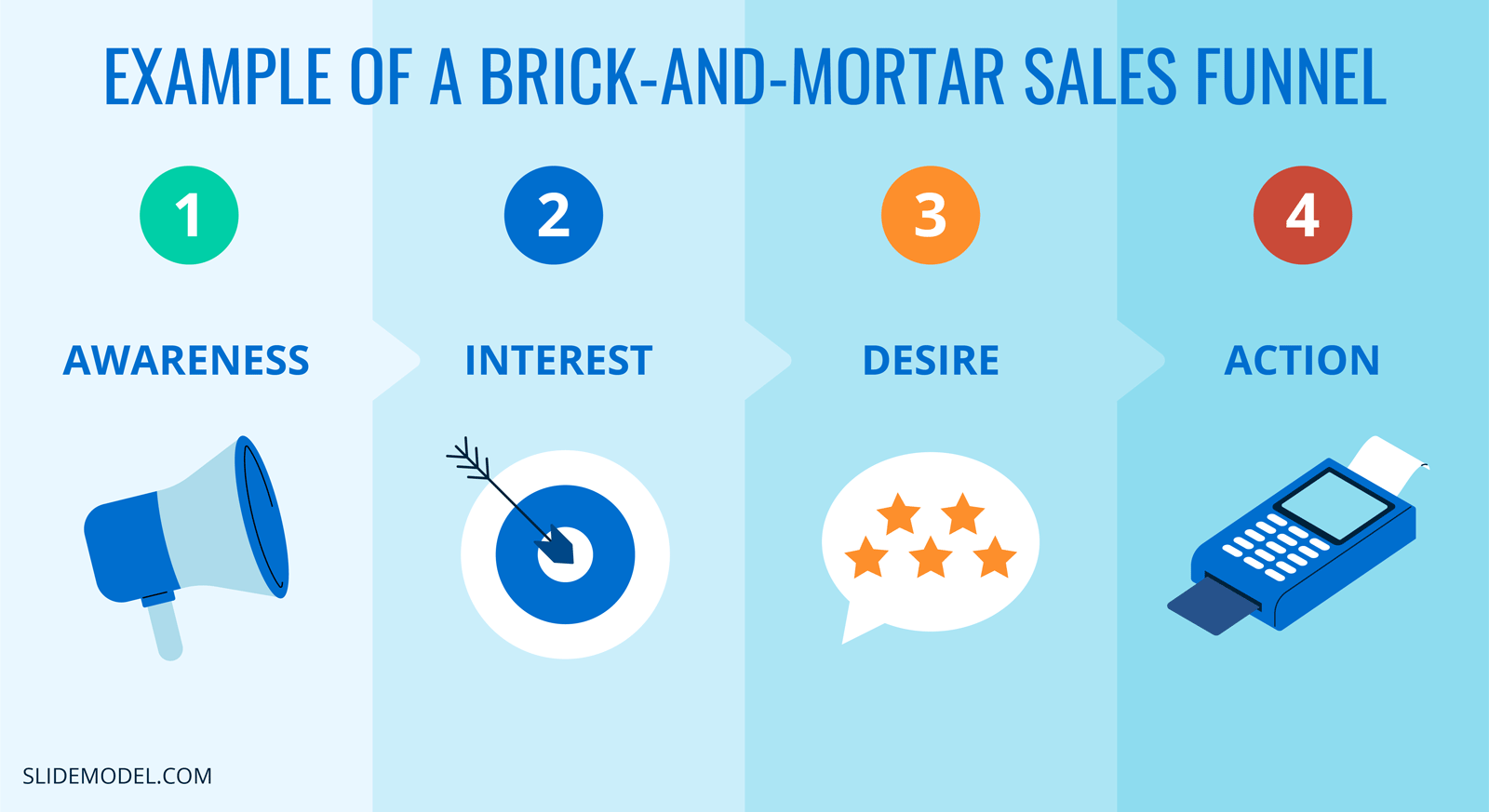
Awareness:
Considering a fashion clothing store, the people that learn about the business while walking by the store, through advertisements, or word-of-mouth are at the top of the funnel as they are either attracted and move on to the next stage or just walk by without interest.
Interest:
As prospects walk in they look around to find something they like, develop an interest, check out the product range and eventually move on to the decision phase.
Decision:
After taking an interest, prospects decide if they should actually buy the items they like. They compare options, consider price brackets, and also inquire about discounts, after-sale services, and return and exchange policies to help them make the decision.
Action:
The last step at the bottom of the funnel is action, where the customer either takes their pick of products to the checkout or they walk out and don’t make a purchase.
Example of an Ecommerce Website Sales Funnel
Awareness:
E-commerce websites usually attract visitors through social media campaigns, advertisements, digital marketing, influencer marketing, referrals, and Search Engine Optimization (SEO).
Interest:
Once visitors get to the website, they browse through the product catalog to find something they like, learn more about the products, do research by comparing other options available then move on to the decision stage.
Decision:
This is where businesses need to promote their products through proper after-sale services and discounts customers cannot refuse and prompt them to take action through an effective landing page with an irresistible time-limited offer.
Here informational content via blogs, newsletters and reviews can also be shared with potential customers, so it becomes easier for them to make a decision.
Action:
In the end, all that’s left is taking action, where the customer either hits the purchase button or they leave their cart behind.
Quick List of 9+ Sales Funnel Templates for Presentations
After gathering the necessary data, building a sales funnel can be straightforward with the help of SlideModel’s editable PowerPoint and Google Slides’ presentation templates.
The sales funnel templates are made to define each funnel step in detail and help discuss the sales approach and strategies using appealing elements, captivating animations, and illustrious data charts and graphs. Furthermore, by using 100% editable funnel diagrams, you can save a lot of hours of manual work. Each of the sales funnel templates contains a pre-defined number of sales funnel stages with text placeholders that you can edit and customize.
Here are some of the best sales funnel templates for creating, optimizing, and presenting the sales funnel to the company’s marketing team. All templates below are compatible with Microsoft PowerPoint and Google Slides presentations.
Conclusion
In today’s competitive market, a sales funnel is important for every business to survive.
However, building a sales funnel, and an effective one at that, takes time, and a proper understanding of the market, the target audience, and their behaviors.
Marketers need time to create a sales funnel and optimize it over time by evaluating why some prospects buy and why some fall through the sales pipeline.
Adjusting the sales approach at different stages, experimenting with various sales strategies, and analyzing the results can help marketers figure out what’s working and what needs to be changed to increase conversions and profitability of the sales funnel.
